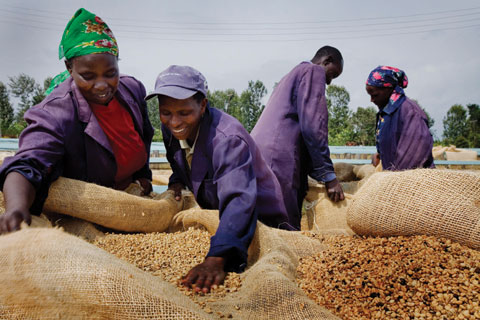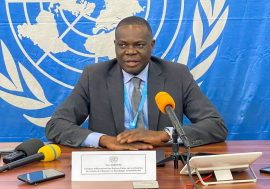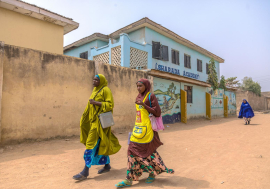Africa's least developed: lands of opportunity
Africa's least developed: lands of opportunity
 Workers at a cotton mill in Mali: While aid remains important, many least developed countries also want more foreign investment.
Workers at a cotton mill in Mali: While aid remains important, many least developed countries also want more foreign investment. Two foreign shoe sellers were once sent to Africa in search of new customers, according to an often-told tale. At the sight of locals marching barefoot, the first seller — a cautious fellow — retreated in despair, advising his company to look elsewhere. The second — a bolder character — rejoiced at what he saw as an untapped market. He ordered thousands of shoes, sold them to the locals and became a wealthy man, or so the legend goes.
There is an appealing parallel that Cheikh Sidi Diarra, the UN special adviser on Africa and high representative for least developed countries (LDCs) is willing to draw between this story and the reality of the world's 48 LDCs (33 of which are in sub-Saharan Africa): "Despite the many ills these countries endure, the world needs to start looking at them more as lands of opportunities rather than a burden," he says. Urging investors to consider nations often associated with endemic poverty, disease and instability as a potential business magnet is a bold invitation. Yet the call is in line with the general tone of an international gathering that Mr. Diarra led in May in Istanbul, Turkey.
Less 'aid talk'
Since 1981 the once-a-decade UN conference has focused on the plight of the world's most vulnerable countries (as defined by low per-capita incomes, low standards of living and high vulnerability to economic shocks). Its aim has been to mobilize international support, including by encouraging developed countries to disburse more aid to LDCs. In the past, much time has been devoted to this issue, pitching advocates of aid against those expected to disburse it.
This time, however, talk about aid was not as central as in past meetings. That was in part a result of the budget constraints imposed on rich countries by a frustratingly slow economic recovery from the global downturn. "Donors are not in a generous mood," one diplomat revealed days before the Istanbul conference. Also, a growing realization that aid alone cannot solve the fundamental problems LDCs face added to what some see as a welcome shift away from the usual debates. Business people and civil society representatives were in fact among the most noticeable and active of the 9,000 participants at the five-day Istanbul meeting.
Ultimately, the Programme of Action agreed upon in Turkey renewed aid commitments made at the previous conference in Brussels, Belgium, 10 years ago. Once again donors pledged to devote between 0.15 and 0.2 per cent of their gross national incomes (GNIs) to aid the LDCs.
Civil society groups in Istanbul criticized that as too little. "Having caused massive costs in the LDCs through financial and food speculation, unjust trade rules, illegitimate loans with onerous conditionality and ecological damage, including climate change, the developed countries have not even committed to provide more aid to LDCs," they said in a declaration. It is a charge that Mr. Diarra disputed. Although not new, this promise of aid remains an important one, he argued, adding that if fulfilled, it would likely raise the amount of aid actually going to LDCs from its current annual level of $38 billion.
More trade, investment
Despite the talk of aid, the emphasis in Istanbul was on trade, investment and productive capacities. Months before the meeting, trade issues were at the centre of some of the most heated debates among negotiators during the lengthy preparatory talks. Along with other partners, African LDCs called for the adoption of a long-debated scheme that would allow all their exports to enter developed-country markets without any duties or quotas. Such preferential treatment was considered a step too far by most developed countries, however, even though LDCs' share of world trade currently stands at only 1 per cent.
The charms of the crossroads city of Istanbul did not change any minds. Instead, there was renewal of yet another decade-old commitment: tariff-free access to developed nations' markets for 97 per cent of LDCs' exports (see Africa Renewal, June 2001).
Unfortunately for African LDCs, this arrangement provides little benefit, according to a report by the International Food Policy Research Institute (IFPRI), a US-based think tank.* The 3 per cent of exports excluded from tariff-free treatment covers some of the countries' most important export products, including agricultural commodities such as sugar, rice, meat and dairy products. Africa will benefit only if all its exports are given full access to developed countries' markets, the report notes. There is hope that a better deal could be reached at the seemingly never-ending Doha trade talks at the World Trade Organization.
African LDCs' quest for more foreign investment arguably received a stronger boost at the meeting. A set of measures designed to encourage developed countries' corporations to invest in LDCs was adopted, with governments expected to encourage their companies to invest in LDCs by providing favourable fiscal incentives and special lines of credit.
Although the continent is fast becoming an attractive destination for foreign investors (see Africa Renewal, April 2011), such incentives are much needed. "Our minds now are on how to get private investment coming from outside.... We think that has the foundation to help us move on the economic front," affirmed Dede Ahoefa Ekoue, Togo's minister for planning and development, in an interview with The Guardian, a British newspaper.
In recent years the 33 LDCs from Africa have benefited most from the growth in foreign direct investment (FDI) to LDCs, which rose from $4.1 billion to $32.4 billion between 2001 and 2008. African LDCs accounted for almost half of that total. Yet not only did FDI's eight-year growth come to a brief halt following the global recession, it also appears that FDI is mostly oriented toward just a few sectors, such as oil and minerals. As a result, few jobs have been created and strong growth in oil-rich countries such as Angola and Equatorial Guinea has yet to translate into meaningful change in people's lives.
Such trends must change if foreign investment is to help reduce poverty, which affects over half the population in the continent's LDCs. In order for it to do so, the Istanbul Programme of Action calls for economic diversification to reduce African LDCs' dependence on the extractive sector.
One major point of agreement among delegates in Istanbul was the need to invest in productive sectors, including agriculture, industry and infrastructure. The Programme of Action refers to these as "development multipliers," as improvement in each area will benefit others. In an era of rising food prices, the call for further investment in agriculture is of particular interest to Africa, as the continent spends around $33 billion every year on food imports.
 Sorting Kenyan coffee beans for export: Trade issues were hotly debated at the Istanbul conference on LDCs.
Sorting Kenyan coffee beans for export: Trade issues were hotly debated at the Istanbul conference on LDCs. Business deals
Aside from policy-makers' agreements and disputes, the LDC conference was an opportunity for hundreds of African businesspeople to conclude deals with their foreign counterparts. A trade fair designed by its organizers as a "matchmaking event" was considered the "most important aspect of the conference" by Abdullah Gül, the president of Turkey.
Although it is too early to assess the deals African entrepreneurs sealed in Istanbul, their mere presence and the interest expressed in some of their ventures confirmed the rapidly evolving perception of the continent, at least in business circles, as an emerging market with great potential.
As the rest of the world hears calls to look at the continent in a more positive way, are the continent's LDCs ready to seize the opportunity? "There is no doubt many African LDCs are performing better. Sound economic policies are leading to strong improvements in various areas," asserted Mr. Diarra. In Rwanda for example, the adoption of an ambitious information and communications technology plan is transforming the country into a regional hub. Malawi and Sierra Leone managed to boost productivity in agriculture in a matter of just a few years (see Africa Renewal, April 2011).
Based on their strengths and needs, more African LDCs should follow suit, Mr. Diarra urges. If they do, the legendary foreign shoe sellers arriving in Africa may be left only with the impression that they came in far too late.
Africa’s ‘group of 33’
Since 1971 when the least developed countries (LDCs) category was created by the UN, sub-Saharan African countries have dominated the list. Four decades later, with 33 members (only 14 of the region's 47 countries are not LDCs), sub-Saharan Africa still maintains the biggest regional presence in the group. All parts of the sub-continent are represented. In recent years, two countries from the continent, Botswana and Cape Verde, have graduated out of the category. Analysts say others (including Angola and Equatorial Guinea) have the potential to join them. However, the newly created state of South Sudan is widely expected to join the LDCs group.
Africa's LDCs are highly diverse, but most have in common an average growth of around 5 per cent in recent years. Of these countries, oil exporters (Angola, Chad, Equatorial Guinea and Sudan) and mineral producers (the Democratic Republic of the Congo, Guinea, Mali, Mauritania, Mozambique and Zambia) benefited most from the surge in demand for commodities, mainly from the emerging economies of China, India and Brazil. Such a trend has led to an increased dependence of their economies on primary commodities, according to the latest Least Developed Countries Report of the UN Conference on Trade and Development (UNCTAD).
One feature of African LDCs is their high rates of return on foreign direct investments, at around 13 per cent. UNCTAD says that investing in LDCs is a smart move. "Rates of return on foreign direct investment … are much higher than on investment in developed, or even other developing, countries."
- Angola
- Benin
- Burkina Faso
- Burundi
- Central African Republic
- Chad
- Comoros
- Democratic Republic of the Congo
- Djibouti
- Equatorial Guinea
- Eritrea
- Ethiopia
- Gambia
- Guinea
- Guinea-Bissau
- Lesotho
- Liberia
- Madagascar
- Malawi
- Mali
- Mauritania
- Mozambique
- Niger
- Rwanda
- São Tomé and Príncipe
- Senegal
- Sierra Leone
- Somalia
- Sudan
- Tanzania
- Togo
- Uganda
- Zambia
* The Costs and Benefits of Duty-Free, Quota-Free Market Access for Poor Countries, International Food Policy Research Institute, June 2010.



















